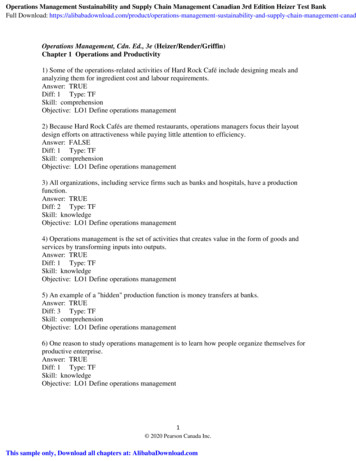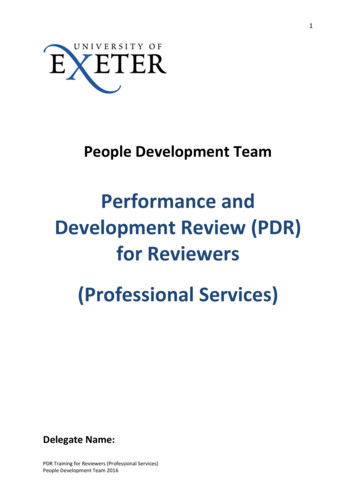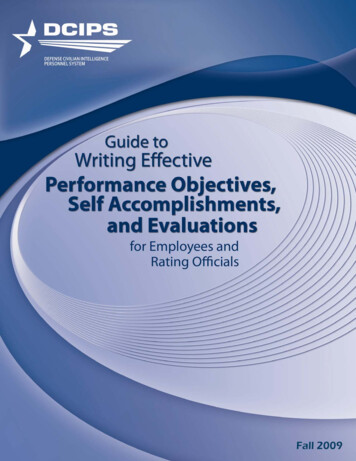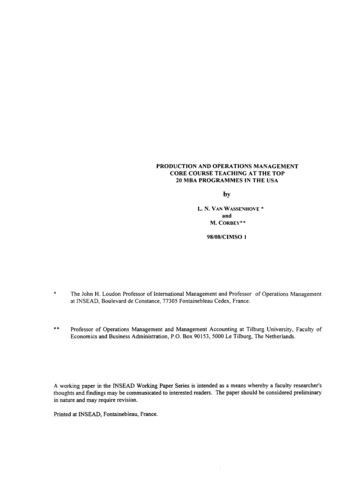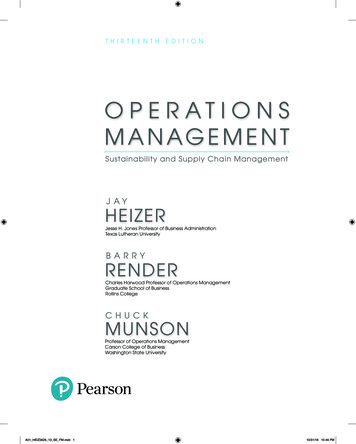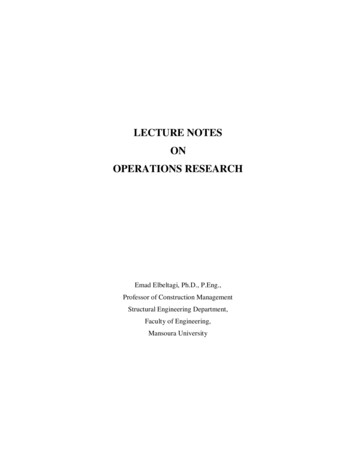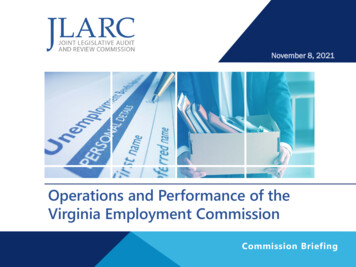
Transcription
November 8, 2021Operations and Performance of theVirginia Employment CommissionCommission Briefing
Study mandate Review the operations of the Virginia EmploymentCommission (VEC), including: JLARCCOVID-19’s impact on VEC and effectiveness of response;administration of Unemployment Insurance (UI) program,including overpayments, appeals, and customer service;IT systems and UI modernization project;sufficiency of agency staffing, funding, and management; andUI benefits compared with other states.2
In this presentationUpdate on previous findings and recommendationsUI fundingUI staffingAgency managementUI trust fund solvency and employer taxesUI benefit levelsJLARC3
Key VEC interim report findings (Sept. 2021)Processing of claims and appeals has not been timely andsignificant backlogs have accumulated.Call centers answering only a small portion of calls, largelybecause of insufficient IT systems and staff.Reliant on paper-based, manual processes; modernizedsystem expected to improve claims process.Rate and dollar amount of incorrect* benefit payments—including to fraudulent actors—increased substantially.VEC communications to customers and own staff havecaused significant frustration and confusion.* VEC and U.S. DOL refer to these as “improper payments.” Improper payments can result from mistakesmade by claimants, employers, or VEC. They can also result from fraud, but majority do not.JLARC4
Status of Sept. briefing recommendationsJLARC recommendations (September 2021 briefing)Initiated(as of 11/1/21)VEC develop a detailed plan that includes specificactions and a timeline to resolve adjudications andpreviously bypassed claims issues by 11/1/21. VEC develop new tools, such as instructional videosand UI eligibility “wizard” to help claimants betterunderstand UI program. VEC collect feedback on usability of new UI benefitssystem from claimants and employers and sharefeedback and steps to improve by 12/31/21 and at theend of each quarter in 2022. Not initiated(as of 11/1/21)VEC Commissioner ensure key developments arecommunicated clearly and expeditiously to all VEC staff,especially leadership or positions communicating withthe public. Note: See Appendix E of written report for a complete list of JLARC’s recommendations.JLARC5
Status of Sept. briefing recommendations,continued JLARC recommendations (September 2021 briefing)Initiated(as of 11/1/21)Not initiated(as of 11/1/21)VEC clarify in internal policies and notices thatclaimants who disagree with monetary determinationsshould request a redetermination. VEC provide a written quarterly update on call centerperformance by 12/31/21 and at the end of eachquarter in 2022. *VEC revise UI forms, notices, and other explanatorydocuments to more clearly describe UI program,eligibility criteria, and application process. *VEC should develop a detailed plan with actions and atimeline for addressing tax system problems with its ITmodernization contractor. *Note: See Appendix E of written report for a complete list of JLARC’s recommendations.*Recommendation implementation is not yet applicable.JLARC6
Several VEC backlogs decreased since Sept. briefing,but potentially fraudulent claims and appeals increasedBacklogPerformancereportedSept. briefingPerformancereportedNov. briefingChangePending adjudications 100K 62K-38K(-38%)Previously bypassed UIclaims issues 2M* 437K-1.56M (-78%)Separation reports 580K 580K**--Potentially fraudulentclaims 136K 164K 28,500( 21%)First-level appeals 62K 76K 14,200( 22%)025 25Commission-level appeals* Number presented in September reflects totals from May 2021.**As of August 2021; updated figure not available.JLARC7
Additional recommendationsVEC should formalize actions it took during the pandemic toprioritize claims for adjudication. Policy should detail howpriorities may change with claim volume. Policy shouldprioritize resolution of older claims.VEC should develop a plan by December 31, 2021 forinvestigating the backlog of potentially fraudulent claims andestablish a strategy for prioritizing investigations by thepotential dollar amount.*See Chapters 4 and 5 of written report for more information about these recommendations.JLARC8
VEC’s total estimated* incorrect payments haveincreased, and overpayment collections still paused VEC is estimated* to have issued 930M in incorrectpayments in 2020 and 322M in 2021 (through June) Estimates are for state UI programSome claims may be transferred to federal programs (e.g., PUA)Fraudulent claims are small portion of estimate Majority of incorrect payments are overpayments VEC is federally required to try to recover overpayments, buthas paused collections, including confirmed overpayments*VEC provides estimates of incorrect payments quarterly to the U.S. Department of Labor through theBenefit Accuracy Measurement program. Estimates are based on a random sample of paid claims.JLARC9
Key driver of incorrect payments is delayedsubmission of employer separation reports VEC staff review employer separation to determine UIeligibility; describes why claimants left their job Separation-related incorrect payments are leading cause ofoverpayments; 59% of 2020 overpayments; 25% of overpayments (2016-2019) U.S. DOL requires VEC to issue first payments within 21 days,even if separation reports have not been reviewed DOL has free tool (SIDES) for employers to submit reports toVEC electronically, but 10% of VA employers participate JLARCMost employers submit reports through U.S. mail10
RecommendationsVEC should immediately resume overpayment recoveryactivities for all confirmed overpayments.General Assembly may wish to consider requiring employersto provide separation information to VEC electronicallythrough the existing SIDES tool or VEC’s UI IT system ratherthan through mail.*See Chapter 5 of written report for more information about these recommendations.JLARC11
Policy option for considerationGeneral Assembly could create a pilot program that wouldrequire a sample group of employers to proactively providea separation report to VEC and former employees each timean employee separates from employment, even if anemployee has not yet filed a UI claim.VEC could evaluate the impact on UI claims accuracy andtimeliness and collect feedback from employers on theadministrative burden.Note: JLARC staff propose policy options instead of recommendations when (i) the action is a policyjudgment best made by elected officials, (ii) evidence suggests the action could be beneficial,or (iii) a finding could be addressed multiple ways.JLARC12
VEC’s UI call center performance is better but stillneeds improvementBacklogCalls presentedPerformanceLatest availableas of June 2021 data*Change 3.3M 1.4M-2M (-61%)4%12% 8 % points( 200%)Calls blocked 490,000 71,000-419,000 (-86%)Average wait 10 hours 20 minutes-9 hours (-97%)% calls answered Quality monitoring and workforce management softwareimplemented for call center in October 2021 Important for monitoring call quality, staff assignmentsSoftware solution provided through Verizon/VITA;delayed 6 months*Calls presented, answered, and blocked are monthly data for September 2021. Average wait time ispoint-in-time data as of a date in October 2021.JLARC13
Additional recommendationVEC should establish and maintain a dedicated qualitymonitoring team composed of VEC staff from eachcustomer contact center. This team should use qualitymonitoring software to regularly review and assess callquality and performance and identify staff training needs.*See Chapter 4 of written report for more information about this recommendation.JLARC14
VEC delayed launch of modernized UI benefits ITsystem until November but mitigated several risks UI benefits system launch delayed one month to earlyNovember (currently in progress) VEC assessing ability to enable automatic text pushnotifications to inform claimants of changes to their claims Data conversion accuracy improved 99% of data converted; 92% accurate (as of late October) Additional VEC staff trained to use modernized system Remaining risks staff turnover, system defectsJLARC15
Additional recommendationVEC should conduct a request for information to identifyadditional features needed for a modernizedunemployment insurance IT system and hire a vendor todevelop these features or develop them using agency ITstaff.*See Chapter 6 of written report for more information about this recommendation.JLARC16
In this presentationUpdate on previous findings and recommendationsUI fundingUI staffingAgency managementUI trust fund solvency and employer taxesUI benefit levelsJLARC17
Most of VEC’s UI funding supports UI benefits*Total funding includes one-time federal funding provided for UI during COVID-19 pandemic.JLARC18
VEC’s UI operations funding is primarily fromfederal grants VEC received 92M* for UI operations in FY20 87M federal UI operational grant from U.S. DOL 5M from employer penalties (e.g., for UI tax delinquency) UI operational funding grant amount determined bycomplex federal formula Based on multiple factors including historic funding levels,anticipated UI workload, operational efficiency, staffallocation, and salary increasesAdjusted based on other states’ funding needs*Amount of funding from regular funding sources. VEC received an additional 50M in one-time federalfunding in FY20 for operational costs to administer federal COVID-19 programs.JLARC19
FindingFunding for VEC’s UI operations has fluctuated witheconomic conditions, which made it challenging for VECto maintain staffing and improve systems.JLARC20
VEC’s UI operational funding decreased over one-thirdbetween 2009 and 2019, following national trendJLARC21
States report UI operational funding has not alwaysbeen adequate to meet their needs Multiple experts, VEC, and other states describe UI operationalfunding as inadequateMajority of states surveyed by NASWA* in 2018 reportedfacing “serious” or “critical” UI operational funding shortfalls VEC leadership reports inability to pay for essential staffpositions (e.g., adjudication staff) and UI systems (e.g., callquality monitoring and workforce management systems) VEC’s federal UI operational funding was above 50-statemedian in 2019 VEC 36M total; 258 per claim50-state median 27M total; 227 per claim*National Association of State Workforce AgenciesJLARC22
FindingVEC’s inefficient operations have put it at a disadvantagein the federal funding formula for UI operations and haveprevented it from spending the operational funding itreceives as efficiently and effectively as possible.JLARC23
VEC is less efficient than other states for mostUI functionsUI functionVEC timeliness(minutes)50-state mediantimeliness (minutes)Initial UI claims3829 9 min ( 33%)39thContinued UIclaims32 1 min ( 45%)39thNon-monetarydeterminations8053 27 min ( 50%)44thAppeals286233 53 min ( 23%)36thWage records0.090.05 4 sec ( 88%)37th3649-13 min (-27%)8thEmployer taxesVEC performance VEC(per unit)rank**Rankings scaled so state in 1st place is most efficient. Data reflect VEC performance in 2019.JLARC24
VEC has relatively high proportion of administrativestaff compared with other states Virginia had 6th highest portion of staff dedicated toadmin functions (e.g., mail services, printing, data entry) States with higher proportions of admin staff penalizedby federal funding formula Automation is key to maximizing UI operational funding JLARCVEC still largely reliant on manual, paper-based processes(e.g., staff manually type UI claim information into system)UI IT modernization expected to improve efficiency25
RecommendationSecretary of labor should procure a national firm withrelevant expertise to conduct a comprehensive efficiencyreview of VEC’s UI operations to (i) identify specific actionsthat could improve efficiency, (ii) recommendimprovements to staffing and workflows, and (iii)determine whether current funding is adequate to ensureeffective UI operations.JLARC26
Efficiency review should precede infusion ofadditional funding for UI operations Need for more funding unknown, depends on several factors Efficiencies gained after VEC finishes modernizing UI IT system(June 2022)Workflow improvements from JLARC recommendationsResults of third-party efficiency review Virginia does not supplement federal UI operational fundingwith state funds, unlike some other states Potential additional UI operational funding sources couldinclude special administrative tax or state general funds JLARCSome states levy a special administrative tax on employers oremployees27
In this presentationUpdate on previous findings and recommendationsUI fundingUI staffingAgency managementUI trust fund solvency and employer taxesUI benefit levelsJLARC28
FindingVEC has not maintained a sufficient number ofsupervisory staff, particularly in call center, appeals,fraud investigation, and adjudication positions.JLARC29
VEC has too few supervisors to effectively managestaff in key UI roles Supervisors should have 8 direct reports for skilledfunctions; 15 direct reports for task-based functions,according to experts Many VEC supervisors have 20 direct reports Five call center supervisors each oversee 40–60 full-time staffSeveral supervisors in appeals, fraud investigation, andadjudication oversee 29 full-time staff Insufficient number of supervisory staff hinders effectivemonitoring of UI staff performanceJLARC30
RecommendationVEC should establish goals for the ratio of supervisorystaff to direct reports, particularly for call centers,adjudication centers, appeals, and fraud investigations.Agency leadership should regularly monitor ratios andreport on them in the monthly commissioner’sperformance report.JLARC31
FindingSeveral additional actions could help VEC to staff up keyfunctions more quickly during future periods of highunemployment.JLARC32
VEC faced several challenges quickly adding agencystaff and third-party contractors Unable to convert wage positions to full-time positionsbecause of competitive hiring requirements in state law No staff in other state agencies willing to be temporarilyreassigned to VEC Requiring other state agency staff to work at VECtemporarily would have required executive branchdirective National Guard and existing state emergency programs(e.g., adjunct emergency workforce) not mobilized toquickly increase VEC staffJLARC33
RecommendationsRequire DHRM to lead a multi-agency workgroup to examine (i)granting agencies exemptions from certain competitive hiringrequirements in emergency circumstances; (ii) requiring stateagency staff to temporarily support other agencies; and (iii)providing necessary funding to cover the associated costs.VEC should build a reserve of workforce services staff who arecross trained to assist with claims during periods of high claimsvolume.VEC should maintain a staff augmentation contract for callcenter services that can be used to respond when call volumesincrease.JLARC34
In this presentationUpdate on previous findings and recommendationsUI fundingUI staffingAgency managementUI trust fund solvency and employer taxesUI benefit levelsJLARC35
FindingVEC lacks a resiliency plan to help the agency effectivelyplan for periods of high unemployment.JLARC36
Resiliency plans are important tools for helpingagencies continue operations during emergencies Agencies that experience large workload increases andprovide time-sensitive services need to ensure effectiveoperations during emergencies Effective resiliency planning JLARCidentifies potential threats and impacts on operationsdefines highest-priority activitiesconsiders steps to mitigate operational disruptions37
VEC does not have a plan for effective operationsduring high UI claims volume No specific strategies to modify staffing levels(e.g., internal reassignments, hiring) or UI processes No plans for communicating program changes to customers Ohio has plan to change staffing levels and overtime hoursfor different UI claim volumes Oregon has plan describing strategy for publiccommunications about UI during recessionsJLARC38
RecommendationGeneral Assembly may wish to consider requiring VEC todevelop a UI resiliency plan that describes specific actionsthe agency would take to address staffing,communications, and other relevant aspects of UIoperations to ensure efficient and effective administrationof the UI program when UI claims increase.JLARC39
FindingVEC needs additional oversight and assistance to ensurenecessary improvements are made to address UIbacklogs and other areas of underperformance duringCOVID-19, and to better respond to future periods of highUI claims volume.JLARC40
VEC primarily overseen by DOL and executive branch U.S. DOL regularly collects data on VEC programperformance but rarely issues financial penalties for poorperformance Secretary of labor, and previously secretary of commerceand trade, charged with overseeing VEC Legislative Commission on Unemployment Compensationalso helps monitor state’s UI programJLARC41
Stronger administration assistance & oversight, otherexecutive decisions, could have improved outcomes Some of most impactful actions in response to surge in UIclaims were delayed over a year into pandemic Examples – hiring contractors for adjudications & call centermanagement; increasing oversight of UI modernization project;implementing key call center and fraud systems Secretary in a position, as part of governor’s cabinet, to identifyresources/solutions for agencies, especially duringemergencies Essential for future secretaries of labor to ensure VEC heldaccountable for performance and provide assistance as ableJLARC42
Additional legislative oversight is needed JLARC report includes 40 recommendations to help VECimprove performance Temporary legislative entity should be created in near term tomonitor VEC’s recovery from pandemic JLARCCommission on Unemployment Compensation could be givenadditional responsibilities43
RecommendationGeneral Assembly may wish to consider creating a temporarysubcommittee of the Commission on UnemploymentCompensation to monitor VEC’s (i) UI backlogs; (ii) efforts toidentify, prevent, and recover incorrect payments; (iii) UI ITmodernization project; (iv) expenditure of state fundsappropriated for UI operations; and (v) implementation ofJLARC recommendations.Members should include claimant and employerrepresentatives as well as legislators (including members ofmoney committees and other standing committees). Thesubcommittee should meet at least once per quarter and beallowed to sunset on June 30, 2025.JLARC44
In this presentationUpdate on previous findings and recommendationsUI fundingUI staffingAgency managementUI trust fund solvency and employer taxesUI benefit levelsJLARC45
Virginia’s state employer UI tax has three parts State UI taxes 1% of total Virginia business taxesJLARC46
FindingIndividual audits are effective at identifying owed UItaxes, but VEC audits fewer employers than DOL requiresand does not effectively target audits.JLARC47
VEC does not always meet DOL’s standards fornumber of employers and share of wages audited Audits entail VEC staff review of employer wage records;issues identified can trigger more tax collections 3 out of 5 years before COVID-19, VEC audited less thanfederally required 1% of employers and 1% of wages VEC audited 0.9% employers, 0.5% wages (2019) Targeted audits more likely to collect additional tax revenue,but VEC selects majority of employers to audit at randomJLARC48
RecommendationVEC should modify existing UI tax audit policies to requirestaff to conduct at least half of annual audits from list ofemployers at risk of UI tax avoidance. “At risk” should bedefined to include industry and employer-specific factors.JLARC49
FindingChanges to tax design are not necessary but could beconsidered if the General Assembly wishes to increase UIrevenue for trust fund solvency or benefits.JLARC50
Virginia’s UI taxable wage base is low and could beincreased Taxable wage base max amount of employees’income that is subject to UI tax VA’s base ( 8K) is above federal minimum ( 7K) butlower than most states VA tied for 44th lowest nationwide50-state median 14K Low base means that VA employers paying higher wageshave lower effective UI tax rate Half of states automatically adjust their base throughindexing (mostly to a % of average annual wage)JLARC51
Virginia could require more employers to pay min.UI tax or increase max. UI tax for high-use employers Experts recommend avoiding 0% UI tax rates, but4 of 14 Virginia base tax schedules have 0% tax foremployers without recent UI claims Challenging to recoup UI costs from employers that gobankrupt or only use UI during recessions UI tax rates federally required to increase with employeruse to discourage layoffs and place most tax burden onhigh-use employers Virginia’s max tax rate consistent with other states, buthigh-use employers pay less because of low taxable wagebaseJLARC52
In this presentationUpdate on previous findings and recommendationsUI fundingUI staffingAgency managementUI trust fund solvency and employer taxesUI benefit levelsJLARC53
FindingVirginia’s UI eligibility requirements are similar to otherstates.JLARC54
Individuals must meet three categories of eligibilityrequirements to receive benefits*Note: Self-employed and independent contractors (“gig” workers) are ineligible for state UI benefitsbecause they are not attached to an employer that pays UI taxes.JLARC55
Virginia’s eligibility policies largely align with those insample of 12 other states Three types of states compared: neighboring states (MD, TN, WV, KY, D.C.)states with high use of UI (MA, NJ, PA)state with low use of UI (AZ, FL, GA, SD) VA’s eligibility mostly similar to other statesJLARC56
FindingLength of time Virginians can receive UI aligns with otherstates, but UI benefit levels are relatively low.JLARC57
Claimants can earn up to 378 in weekly state UIbenefits for up to 26 weeksNote: Does not include additional federal COVID-19 UI benefits. For most claimants, a full base periodincludes the first four of the last five quarters before their UI claim was filed.JLARC58
Number of weeks Virginians can collect UI benefits islargely comparable with other states Upper limit of Virginia’s maximum duration (26 weeks)is similar to 39 other states 8 states have shorter durations (16–25 weeks)Only MT and MA have longer durations for some claimants Lower limit of Virginia’s maximum duration (12 weeks)is somewhat low compared with other states JLARCChanges unnecessary because most claimants do notcollect benefits for all weeks they are eligible59
Virginia provides lower UI benefit levels than otherstates Maximum weekly benefit ( 378); 37th lowest in 2019 Virginia’s average income replacement ratio 34% in 2019 Experts recommend 50% income replacement ratio Virginia’s UI benefits do not cover basic food, housing, andtransportation costs for many individuals JLARCExample – Single adult working full-time making minimum wageis eligible for 197/week, covers 30% cost of living60
Virginia could consider increasing UI benefits ifGeneral Assembly wishes to do so UI benefit levels are a legislative policy decision UI benefit increases have trade offs Benefit UI claimantsRequire increasing state employer UI taxes or usingalternative funding source (e.g., general funds) 35 other states automatically index maximum weekly UIbenefits to a statewide economic metric (e.g., averageweekly wage) 13 states have dependent allowancesJLARC61
RecommendationGeneral Assembly may wish to consider requiring VEC toannually calculate average Virginia UI benefit levels, theaverage income replacement of UI benefits, and therecipiency rate for UI benefits. VEC should provide thisinformation in its annual report presented to the Commissionon Unemployment Compensation.JLARC62
Policy option to considerGeneral Assembly could authorize the Commission onUnemployment Compensation to convene an advisorycommittee comprising stakeholders and experts to (i) reviewUI benefits, replacement ratios, and recipiency rates; (ii)identify factors that affect UI benefits and recipiency; (iii)assess the advantages and disadvantages of potentialchanges to benefits; and (iv) recommend options to changebenefit levels when needed.*JLARC staff propose policy options instead of recommendations when (i) the action is a policyjudgment best made by elected officials, (ii) evidence suggests the action could be beneficial,or (iii) a finding could be addressed multiple ways.JLARC63
Key findings*VEC’s inefficient UI operations have placed VEC at adisadvantage in the federal funding formula used for UIoperations and prevented VEC from spending theoperational funding it receives as efficiently andeffectively as possible.VEC has not effectively planned for periods of highunemployment.VEC needs additional oversight and assistance to ensureit makes necessary improvements to operations andperformance and responds better to future periods ofhigh UI claims volume.*Does not include findings from September 20, 2021 interim briefing.JLARC64
Key findings, continued*VEC could take additional steps to increase UI employertax collections, which would help maintain the health ofthe state’s UI trust fund that is used to pay UI benefits.Changes to tax design are not necessary but could beconsidered if the General Assembly wishes to increase UIrevenue for trust fund solvency or benefits.Eligibility criteria for UI benefits, and length of timeVirginians can receive them, are comparable with otherstates; weekly benefit amount is relatively low.*Does not include findings from September 20, 2021 interim briefing.JLARC65
JLARC staff for this reportTracey Smith, Associate DirectorLauren Axselle, Project LeaderSarah Berday-Sacks, Senior AnalystNick Galvin, Senior Associate AnalystLandon Webber, Senior Associate AnalystDillon Wild, Associate AnalystJLARChttp://jlarc.virginia.gov/(804) 786-125866
Nov 08, 2021 · JLARC VEC is estimated* to have issued 930M in incorrect payments in 2020 and 322M



